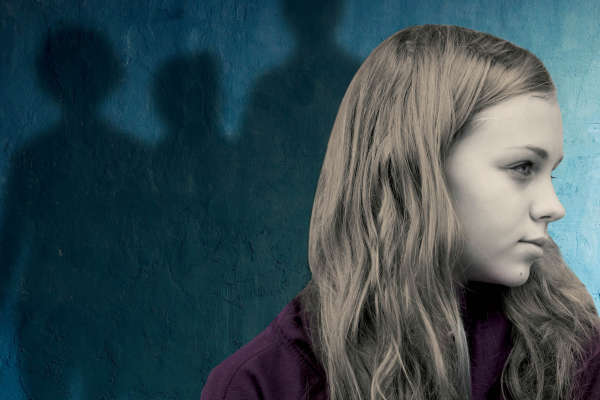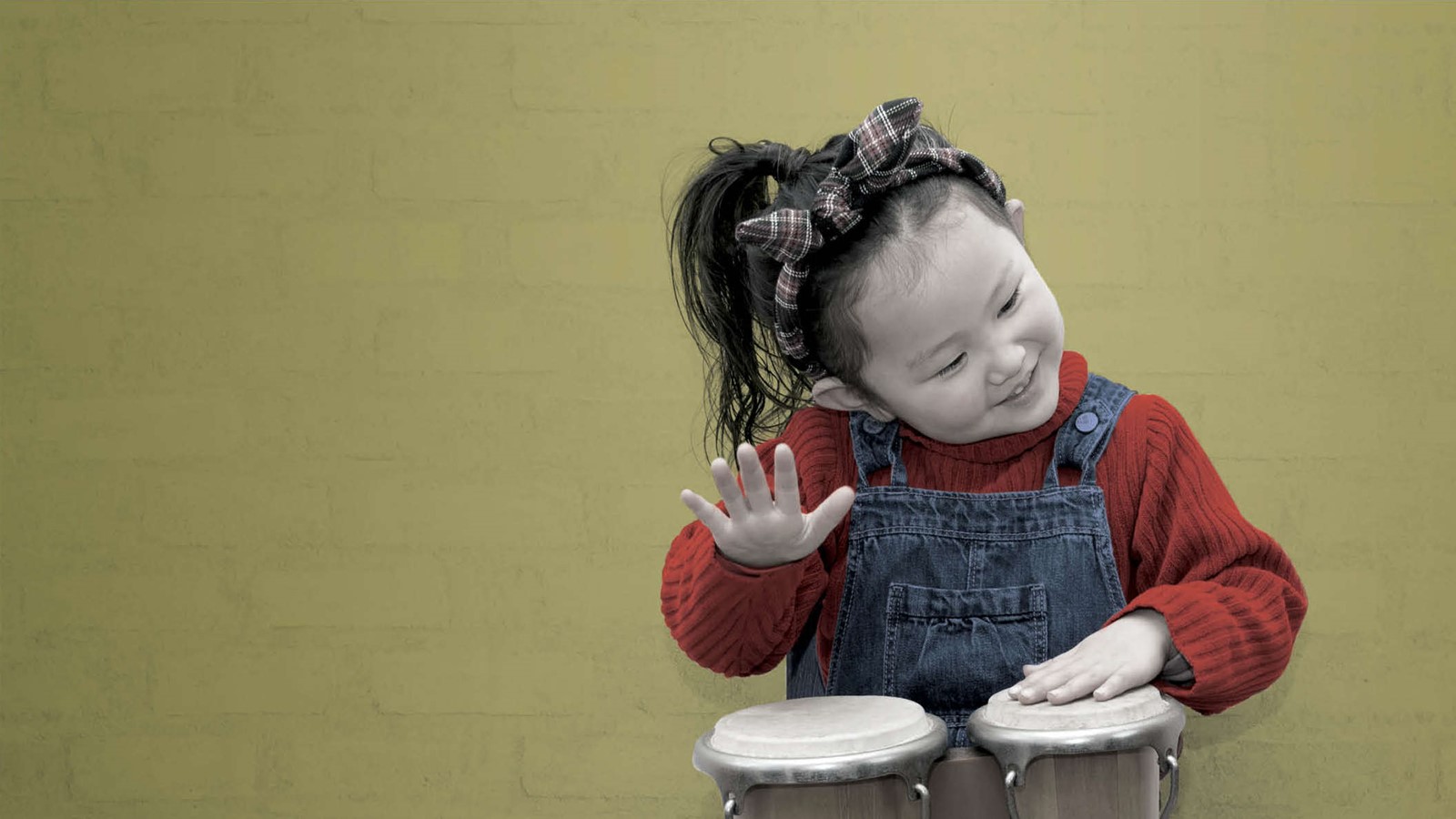Sami sat happily on a waiting room chair, holding her conga drum. Our first session had gone smoothly after a tentative start. Trying new things and meeting new people were challenges for Sami, though she began to warm to me as she talked about her favourite thing to do in the world. This six-year-old drummer and bassist was all about music. Her eyes sharpened, her body eased and her voice rose as she talked about her instruments.
As she spoke, and hummed a few tunes, I felt enlivened and drawn to Sami’s palpable joy. Over the years, I’ve enjoyed a range of music in my office, as kids like to share a song or even play it in the background of our sessions. Anything from the Beatles to Lady Gaga, Taylor Swift and even Mozart, among others. It helps that I enjoy music in almost all of its varieties. In the office, I’ve found music a kind of emotional soundtrack, facilitating a child’s comfort, layering a bit of affect, or adding a potential line of communication. Music may be especially relevant when working with teenagers, for whom it can be a measure of identity, but younger children, Sami for instance, can be quite engaged as well. Music was part of this skilled young musician’s language and I began to think of ways to both integrate it into our sessions and into techniques that could help Sami with her anxiety.
‘I brought a drum, Henry!’ Sami smiled enthusiastically. I looked to match her energy and appreciate this gift she had brought to our session. ‘I see,’ I smiled as I knelt down. ‘Will you play it?’ Sami nodded her head with an almost tense exuberance. ‘Fantastic. I can’t wait!’ I said. ‘Should we get started?’ And as I gestured towards my room, Sami led the way. ‘Henry, do you have a drum here?’ she wondered. ‘No, I’m afraid not.’ ‘Do you know how to play the drums?’ she continued. ‘No, I can’t.’ ‘What instrument do you play?’ Sami asked, sweetly and hopefully. ‘Well,’ I explained, ‘I don’t actually know how to play any.’ Sami looked surprised. ‘Why not? You like music?’ ‘I do, but I never learned how to play. I tried once, with the piano, but I wasn’t that good at it.’ Sami looked at me incredulously. ‘Henry, you don’t have to be good at it to play an instrument. You just play it. It’s music.’ She had a point. I do wish I’d learned to play something, anything really. ‘Why didn’t you learn something else?’ Her voice was earnest and non-judgmental, but this was getting challenging. I wouldn’t mind asking Sami about her own challenges, but her talking about mine seemed as if it might be a more comfortable route for her to the topic of anxiety. ‘You know, I think you’re right. I do wish I’d learned how to play an instrument. After the piano, I just got kind of busy with other school stuff and I guess I enjoyed listening to music more than learning how to play it.’ Sami mulled this over. ‘You could get a drum set!’ She looked at me so sweetly, wanting to share her musical world. ‘Well, I’ll think about it. How about that?’ I deflected as a sceptical Sami looked at me.
‘Can I play something now?’ she asked. ‘Yes, I’ve been looking forward to it,’ – and with that, Sami started on a beat. I bobbed up and down, then decided to join in and expand the drumming into play. I grabbed some of my plastic animals and they moved to the rhythm. A couple even played air guitar and drums. And we danced. Sami, me, two giraffes, a panda, two dinosaurs, a tiger and a chicken. I wanted to keep expanding our play, so I started to move us around the room, giving Sami a chance to fully take in the playhouse, castle, toys, figures and puppets that she had barely glanced at a week earlier. I could see her studying the toys now as she took in the space. We paused for a moment to catch our breath. ‘Well, that was terrific!’ I said. ‘Felt like Woodstock,’ one of my dinosaurs added.
Sami smiled, looked at me for a second and then back at the dinosaur. ‘You know about Woodstock?’ she asked him. ‘Of course, we’re big fans here. We love music,’ as my T. rex pointed to the toy miniature piano that was part of the house.’ ‘You can play?’ Sami asked the dinosaur. ‘Does a cow moo?’ he replied. ‘Of course.’ ‘Will you play something?’ ‘Sure, I’ll be happy to.’ So, my T. rex stood at the wooden piano and I thought about what to play. What kind of music would a piano-playing T. rex prefer? I figured I’d just embrace whatever first came out of my head. To a delighted Sami, the dinosaur started playing Beethoven. ‘That was good,’ she laughed. ‘Do you know any rock songs?’ ‘Any requests?’ ‘No, you play what you want.’ For some reason this felt harder. There’s something personal in music and I wasn’t sure where to go. I stayed safe and started out with Yellow Submarine as Sami joined in on the conga and the rest of the crew followed. Our session ended without there having been a word about anti-anxiety strategies. A couple of days later, Sami’s parents called to tell me how the typically tentative Sami cheerfully enjoyed a smooth play date and had an easier time with her reading tutor. I was pleased, but extremely wary of a two-session cure.
Enter some unease
‘I have music for you to play today, Henry,’ Sami told me the following week. Her babysitter looked at me as we stood in the waiting area and nodded sagely: ‘Yes, it will be good for Henry to hear.’ ‘Great – what are we going to listen to today?’ Sami looked up at me with a big smile and walked into my office. ‘I learned this one from the Guitar Hero game!1 Can I play it on your phone?’ I hesitated for a moment, but I also trusted Sami and was intrigued. ‘Sure,’ I said, and waited as she scrolled through the music app, her eyes locked intently on the screen, searching for the song she wanted.
A great buzz of distortion blared out of the small speaker of my phone, as I gestured to Sami to turn the volume down a bit. I do, after all, share an office suite with other therapists. Stomping drums and crunching guitar riff followed. I looked at Sami as I tried to contain my own mix of surprise and unease as an uncomfortable realisation dawned. I braced for the vocals.
Has he lost his mind?
Can he see or is he blind?
Can he walk at all,
Or if he moves will he fall?
Is he alive or dead?
Has he thoughts within his head?
We’ll just pass him there
Why should we even care?
He was turned to steel
In the great magnetic field
Where he travelled time
For the future of mankind2
A very pleased Sami danced as she played me the song Iron Man by Black Sabbath.
Black Sabbath, pioneering heavy metal band. Now what was I supposed to do? How could I let her play this stuff? Was this supposed to be therapeutic? But she loved it. Maybe she just wanted to test me out. But bouncing around, she looked genuinely delighted. Was she trying to tell me something? Older kids who become heavy metal fans may channel anger, rage, or alienation this way. Sami was hopping around my office, playing air percussion and guitar. What did this music mean to her? I’ve never been a metal fan and struggled to see Sami’s interest as anything other than inappropriate. I thought about the people in my waiting room who must have heard the music coming from my office. I could just imagine their faces when I walked out later. Where was Elton John when you needed him? Was this some way of overcoming her fears? Turning fear into anger? Were the fears themselves perhaps a mask for her more hidden aggressive side? There she was, smiling and dancing, looking absolutely free. Sami looked at me. ‘It’s fun. C’mon, dance, Henry!’ ‘Sure, why not,’ I answered, and started moving around rather stiffly. ‘I see you really like this. Where did you hear it again?’ ‘Guitar Hero!’ ‘Oh, yeah.’ I tried to go with it but I was tight. I didn’t include any of our band of characters, who stayed in their playhouses like statues. In truth I didn’t even think of them.
We did other things in our session that day. We played hide and seek, searched for some bad guys, and chatted for a few minutes about how Sami was doing in school. She had enjoyed some breathing exercises we did to help her relax. But I kept drifting to the music and I could see Sami eyeing my phone. What was this all about?
I’m quite sure that, to many, Sami’s musical choice falls somewhere between irrelevant and harmful. To be quite honest, in that moment, I tended toward the latter. But the song and Sami’s ebullience stuck with me, and I started to wonder. Music was her language, so maybe she was trying to tell me something. On the other hand, that locked-in look of hers felt compulsive, and I felt distant from her while she danced. But was that Sami or was that about me? What if she’d played a depressing New Wave or Post-punk song that I actually enjoyed? Would I have cringed or would I have secretly applauded her precociousness? Maybe I needed to be honest and let the musician in the room find her voice? But heavy metal?
From music to ghosts
Sami came in the following week, made a move for my phone, and the headbanger’s ball was back on. She had expanded her choices now, adding in AC/DC and Deep Purple while rejecting a couple of songs I had suggested. To deal with my anxiety about the music, I decided to set a limit on the amount we’d listen to in session. I wanted to make space for her music but also maintain space for our work, and I wasn’t quite sure where the two met and diverged. After the songs, Sami directed us to play a game. An imaginary group of villains, a rogue’s gallery of robbers, monsters, and demons were chasing the two of us. We successfully dispatched them, but then their reinforcements arrived – ghosts. Scary, spooky and, worst of all, invisible. We didn’t stand a chance as they pushed us further and further into a corner. We tried to hide but it was pointless, as Sami’s ghosts eased through walls and doors and we had no way of knowing where they were coming from. The session ended as we cowered behind a farmhouse, besieged by ghouls, the darkness of Sami’s music echoing in our play.
By the next session, the shock of the music had waned. Sami wanted to keep our ghost play going and she requested that the music play in the background. I felt comfortable with this plan, as it integrated the music into our play. It was a quite an experience, battling demons while Ozzy Osbourne wailed in the background. The play was intensifying and broadening, with Sami and me devising new ways to fight the ghosts. She developed special glasses that allowed us to see the ghosts. We put the chairs in my office together to make a car and enlisted my various puppets to add to our animal friends. Guitars buzzing behind us, we got behind the wheel and hunted our ghoulish foes.
Hunting ghosts. That evening, I left the office thinking about this session. It was playful, intense, and stuck with me. Was it my love of the Ghostbusters movie? No, that was too comedic. Did something resonate in Sami’s play? As I walked outside, my mind wandered to my own childhood. Growing up in New York City in the mid-1970s, my brothers and I used my room for basketball and baseball. The back and forth was fun and intense as we ran, jumped, offered commentary and bantered. And there was music. The radio was always on, scoring the dramas and inspiring us to new heights. I flashed back to the soaring theme song from Rocky filling my bedroom, the tempo of the game intensifying, pushing us to glory in our imagined Madison Square Garden. The music wasn’t a distraction. It was part of the theatre.
My puppets and I greeted Sami at her next session. Pookie is a bird puppet with dreadlocks, and as Sami spoke with him, it seemed apt that he’d be a Bob Marley fan. Sami was interested and I played the song Buffalo Soldier to start the session. She liked it, taking in one of my choices for the first time. We danced to a reggae beat, listened to a little Black Sabbath and transitioned to our ghost drama. With our ghost glasses and ghoul zapper we had turned the tables, but the b*****s were still hard to catch. We drove in our makeshift racing car, but sometimes the directions were off or the ghosts had already moved. We kept hunting for ghosts. At some point I realised the music was off. The play seemed calmer, or maybe just quieter.
A change of tone
‘These ghosts are hard to find. I wish we could track them all down,’ I observed. Sami agreed and suggested we take a break for lunch. We sat on the couch and chair, pulled over a side table, and scoffed down some pretend sandwiches. ‘Where should we look after we’re done eating?’ I asked Sami. ‘There’s a map that we need to find. It tells you where you can find the ghosts,’ she replied. ‘Hmm. Where is this map?’ ‘We have to go into the haunted house.’ ‘Haunted house,’ I gulped, frightened, ‘I don’t know about this. Maybe there’s, like, a copy of the map somewhere? You know, somewhere less scary?’ Sami replied, ‘No, it’s the only map. We’re going to have to go in there. Don’t worry, I know where it is. But there are going to be lots of ghosts trying to stop us.’ ‘If you say so… Definitely no other option?’ I asked hopefully, my face tense. ‘No,’ Sami replied matter-of-factly. ‘We need to find the map.’
We washed down lunch with imaginary smoothies and readied ourselves for the haunted house. We made our way carefully toward the bookcase. I was scared. Sami was brave. The puppets were our lookouts and the animals kept the engine running. ‘Henry, careful!’ Sami whispered urgently as she pointed to the left. I looked back, my eyes frozen wide. ‘Giant demon,’ she whispered again, and told me how to walk carefully so I wouldn’t be noticed. Then she motioned for me to follow and we tiptoed. Suddenly she screamed – ‘Run! Lots of ghosts! Go!’ We ran together and hid behind a chair. ‘Now what are we supposed to do?’ I asked. ‘Just wait for them to run by, then we can get in. But it may take a while.’ ‘A while, like how long?’ ‘A few hours.’ I sighed. ‘What are we supposed to do for a few hours?’ Sami shushed me. We sat there for a moment, behind the chair, and then Sami asked to play me another song. Who would it be this time, I wondered. ‘Henry, have you heard of Elton John?’ At last – age-appropriate music. I readied myself for Rocket Man or maybe the up-tempo I’m Still Standing.
‘It’s called Empty Garden.’ I didn’t know that one. Sami found it and hit play. The soft piano was soon joined by Elton John’s voice and a synthesised harpsichord. Sami and I sat there, hanging around listening to the radio. The song was about some kind of loss – I couldn’t place it exactly and it moved slowly. Finally, a classic Elton John chorus built up and took off.
And I’ve been knocking
But no one answers
And I’ve been knocking
Most all the day
Oh, and I’ve been calling
Oh, hey hey Johnny
Can’t you come out to play
I felt the shiver that a sad song can bring. Goosebumps rising, I sat silent with Sami.
And I’ve been knocking
But no one answers
And I’ve been knocking
Most all the day
Oh, and I’ve been calling
Oh, hey hey Johnny
Can’t you come out, can’t you come out to play
Johnny, can’t you come out to play in your empty garden
Johnny, can’t you come out to play in your empty garden
Johnny, can’t you come out to play in your empty garden.3
How music can engage. A conga beat’s joy. Heavy Metal’s fury. Reggae’s soul. A pop song’s inexplicable capacity to capture loss. My own sense of loss came over me in that moment – of days long ago and so far away. Then I wondered about a connection to Sami. What exactly about this song spoke to her? A footnote in her history expanded, and as I dug, I learned more about a beloved grandparent. An accident. Ghosts. A family trauma we had been working through the entire time. Her initial symptoms had reflected an anxious predilection, but there was much more underneath. What would have happened had I put the kibosh on Black Sabbath that second session? Would I have heard Sami’s voice? Would she have let me in and trusted me? Would we have listened to the songs and headed on our adventures? Would we have sat there on the floor, like old friends, listening to music as the ghosts drifted by?
Henry Kronengold PhD is in private practice in New York City where he specialises in working with children and adolescents. He is also a clinical supervisor in the Doctoral Programme in Clinical Psychology at the City University of New York, and an Adjunct Assistant Professor in Counselling and Clinical Psychology at Teachers College, Columbia University. Henry is the author of the recently published Stories from Child & Adolescent Psychotherapy: a curious space (Routledge, 2017).
More from BACP Children and Young People journal

The transgenerational perspective
Open article: How can grandmothers, uncles, great-grandfathers or long-lost cousins haunt or help a young person’s life? Lucy-Jean Lloyd addresses the question. BACP Children and Young People, March 2017

Admitting the T word
Open article: Jeanine Connor addresses difference in the form of sexuality and gender, including transgender, and invites us to work out how we will welcome all such diversity into our counselling rooms. BACP Children and Young People, December 2016

Adapting CBT for children with an autism spectrum disorder (ASD)
Open article: Sarah Rogers not only adapts cognitive behavioural therapy (CBT) creatively for children but enjoys working with those who are not neurotypical, finding their special interests and skills an asset in the therapy room. BACP Children and Young People, September 2016
References
1 Guitar Hero. RedOctane/Activision, 2005.
2 Black Sabbath. Iron Man. Paranoid, Warner Bros., 1970.
3 Elton John. Empty Garden (Hey Hey Johnny). Jump Up!, Geffen, 1981.
